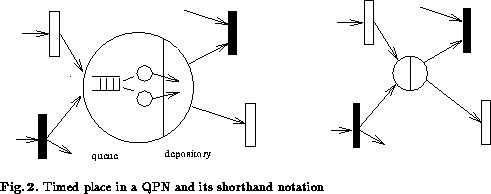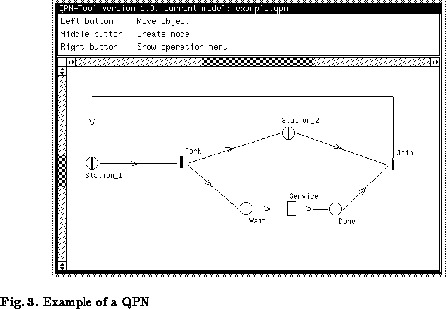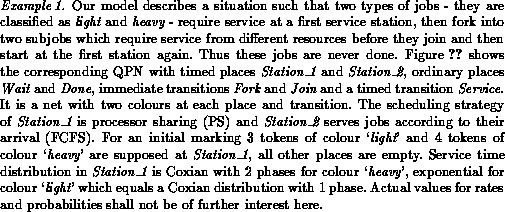


Next: QPN-Tool
Up: QPN-Tool for Qualitative and
Previous: Introduction
 Queueing Petri Nets (QPNs) [6][4][3] combine Coloured
Generalized Stochastic Petri Nets (CGSPNs) [10] with Queueing
Networks (QNs) by hiding stations in special places of the CGSPN which
are called timed places.
The structure of a QPN is determined by a CGSPN with two types of
places and transitions:
Queueing Petri Nets (QPNs) [6][4][3] combine Coloured
Generalized Stochastic Petri Nets (CGSPNs) [10] with Queueing
Networks (QNs) by hiding stations in special places of the CGSPN which
are called timed places.
The structure of a QPN is determined by a CGSPN with two types of
places and transitions:
- ordinary place
- An ordinary place is equivalent to a place in a
Coloured Petri net. Tokens fired onto such a place are immediately
available for the corresponding output transitions.
- timed place
- A timed place contains a queue and a depository. A
token which is fired on a timed place is inserted into the queue
according to a scheduling strategy. The scheduling strategy
determines which tokens in the queue are served. Each colour has an
individual service time distribution of Coxian type. After
receiving service the token moves to a depository, where it is
available to the place's output transitions.
Figure 2 presents a timed place and its graphical
shorthand notation. A timed place can be regarded as a short
notation of a complex CGSPN subnet, which models a Queueing Network
service station. Scheduling strategies like FCFS, which concern the
order of arrival, require a ranking of token colours to handle bulk
arrivals. In case of a bulk arrival all tokens are separately
inserted in succession into the queue in zero time. A token of the
colour with the highest rank is inserted first.
- immediate transition
- An enabled immediate transition fires
according to one of its colours without any delay in zero time. Any
of its colours has a so called `firing frequency', which allows to
compute firing probabilities in case of concurrently enabled
immediate transitions.
- timed transition
- An enabled timed transition fires after a
certain delay. This delay is determined by a colour-specific
exponential distribution. Firing of timed transitions has a lower
priority than firing of immediate transitions. Hence no timed
transition can fire if an immediate transition is enabled. Like in
GSPNs timed transitions obey a `race policy' to solve conflicts.
Firing of a transition is always an atomic action.






The following example focuses on the illustration of the different
elements a QPN can contain and not on modelling anything of practical relevance.


Every QPN describes a stochastic process. A state of this process is
determined by the cartesian product of the state descriptions at all
timed places and the number of tokens at ordinary places with respect
to their colours. If the service time within a timed place is
modelled by an appropriate distribution, e.g. Cox-distribution,
Markov-chain based analysis of the QPN is possible.
The state space is partitioned into two types of states
similar to GSPNs (cf. [1]):
- vanishing states
- Firing of an immediate transition has a higher priority
than any other change of state. Thus the stochastic process immediately leaves
a state in which an immediate transition is enabled. If several
immediate transitions are enabled, the one which fires first is
determined by the firing probability. Firing probabilities are
deduced from firing frequencies by relating a firing frequency to the sum of
firing frequencies of all enabled transitions.
- tangible states
- If no immediate transition is enabled, firing
of a timed transition or serving a token within a timed place can
cause a change of state. The time for this change is determined by
an exponential distribution in case of firing a timed transition or
by the corresponding (exponential stage of the) service time
distribution.
The initial marking of the QPN gives the initial state of its
stochastic process under the assumption that initially all tokens on
timed places are situated on the corresponding depository.



Next: QPN-Tool
Up: QPN-Tool for Qualitative and
Previous: Introduction
![]() Queueing Petri Nets (QPNs) [6][4][3] combine Coloured
Generalized Stochastic Petri Nets (CGSPNs) [10] with Queueing
Networks (QNs) by hiding stations in special places of the CGSPN which
are called timed places.
The structure of a QPN is determined by a CGSPN with two types of
places and transitions:
Queueing Petri Nets (QPNs) [6][4][3] combine Coloured
Generalized Stochastic Petri Nets (CGSPNs) [10] with Queueing
Networks (QNs) by hiding stations in special places of the CGSPN which
are called timed places.
The structure of a QPN is determined by a CGSPN with two types of
places and transitions: